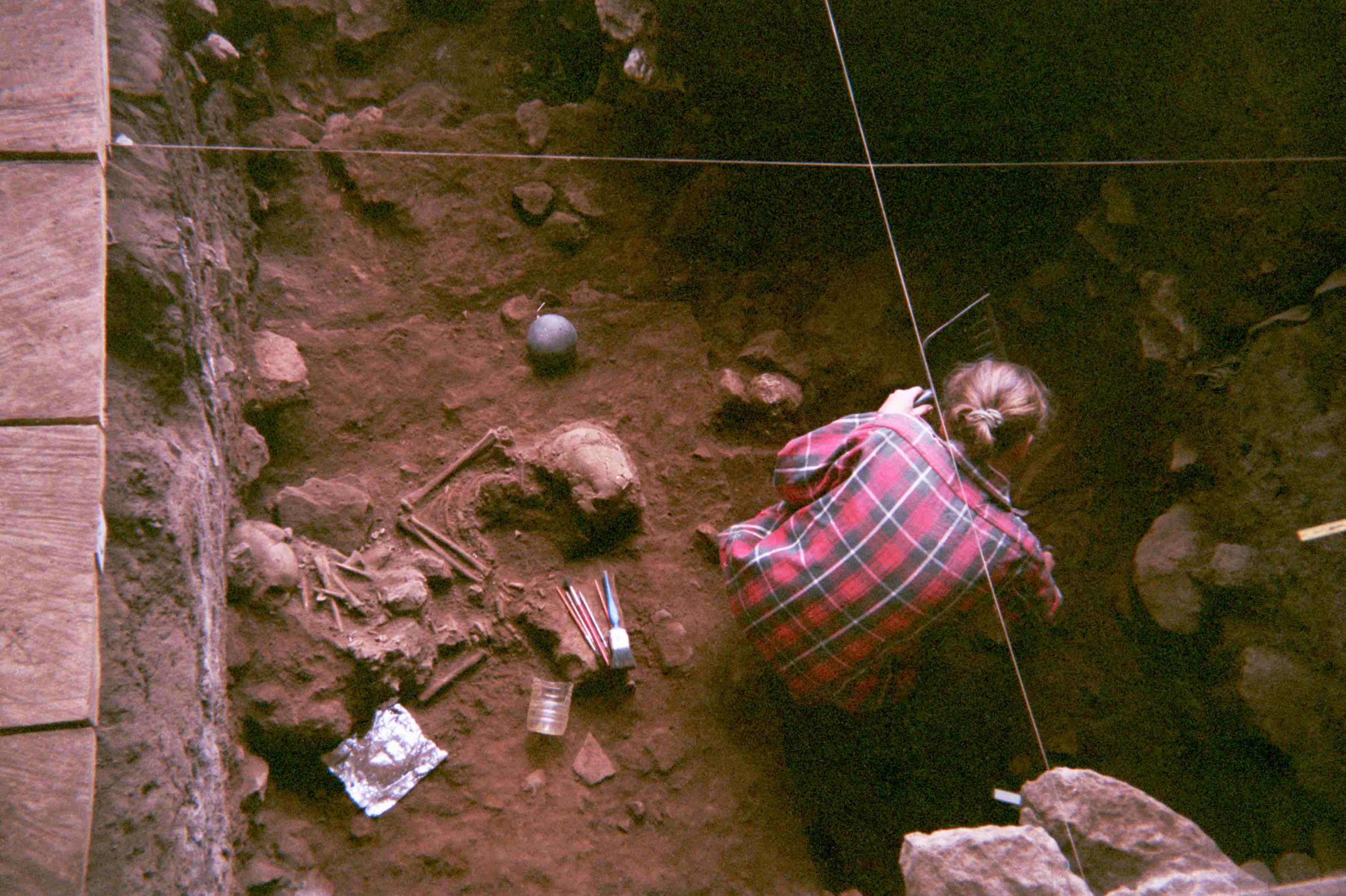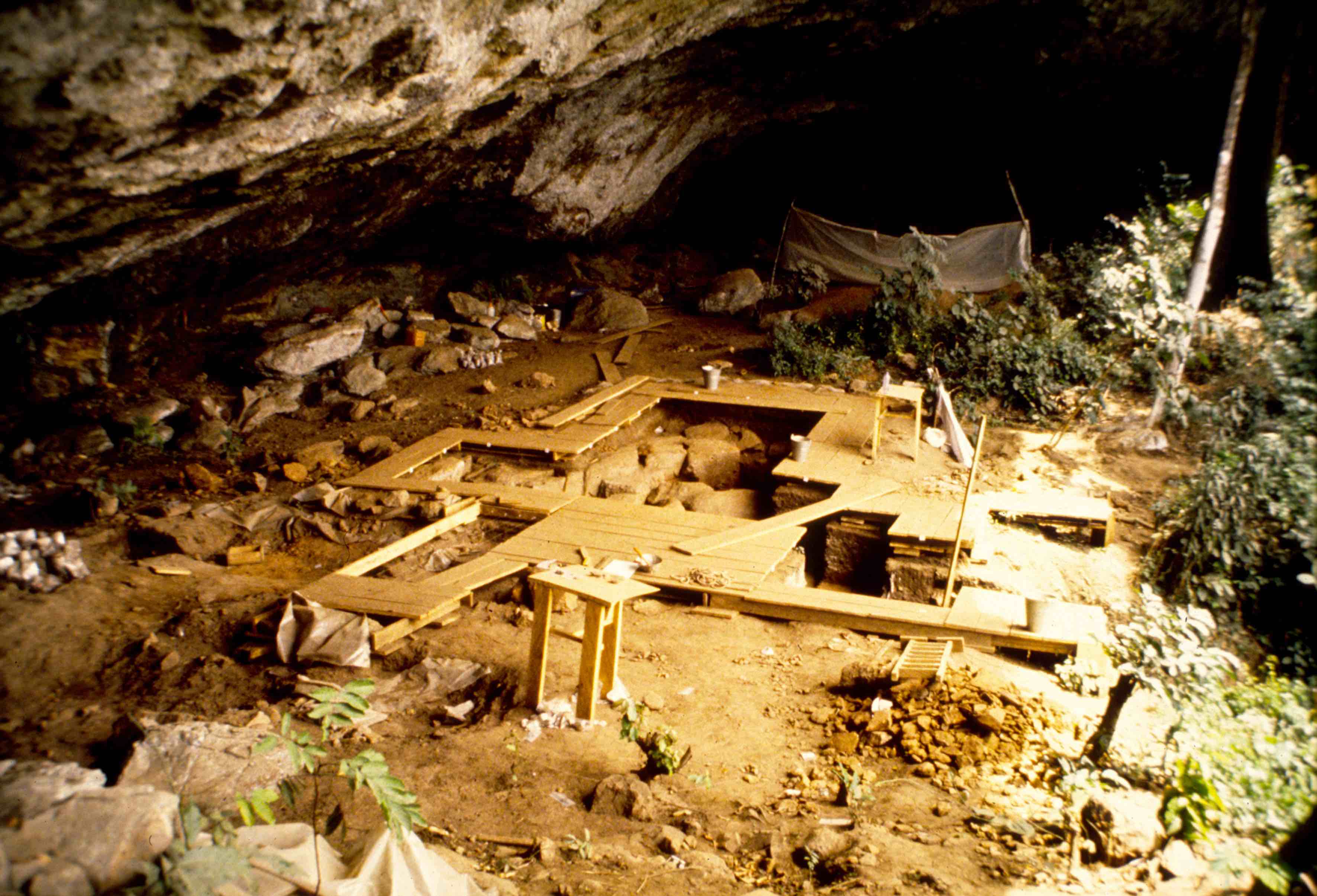The first ancient genome from west Africa sheds light on the human past
The first ancient genome from west Africa sheds light on the human past
- An international team involving the Institute of Evolutionary Biology (IBE) has generated the first complete genome sequences of ancient human DNA from western and central Africa.
- The data, recovered from four individuals buried in the iconic archaeological site of Shum Laka in Cameroon between 3,000 and 8,000 years ago, improve our understanding of the deep ancestral relationships between populations of sub-Saharan Africa, which remains the region of greatest human diversity today.
- The findings, which are published in the prestigious journal Nature, provide new clues in the search to identify the people who first spoke and spread the Bantu languages. The work also identifies previously unknown “ghost” populations that contributed small portions of DNA to today’s African groups.

An international, interdisciplinary team involving the Institute of Evolutionary Biology (IBE, a joint centre of the Spanish National Research Council (CSIC) and Pompeu Fabra University (UPF)) in Barcelona has reconstructed the complete ancient genome of four individuals buried some 8,000 and 3,000 years ago in the rocky shelter of Shum Laka in Cameroon, which is considered the cradle of the Bantu languages - the most diverse and widespread group of African languages.
The study, published in the journal Nature involving the IBE researcher Carles Lalueza-Fox, shows that there were at least four major lineages in the history of mankind, between 200,000 and 300,000 years ago. This branch had not been previously identified from genetic data.
The finding strengthens the argument recently put forward by archaeologists and geneticists that human origins in Africa may have involved deeply divergent and geographically separated populations.
Africa is the cradle of our species, Homo sapiens, and it hosts more human genetic diversity than any other part of the planet. Consequently, studies of ancient DNA from archaeological sites in Africa may shed light on the oldest origins of mankind. However, studies of ancient African DNA remain scarce, partly because of the challenge posed by extracting DNA from deteriorated skeletons in tropical environments.
Now, an international research team led by scientists at Harvard Medical School with the participation of Carles Lalueza-Fox and Inigo Olalde of the Paleogenomics lab at the Institute of Evolutionary Biology (IBE, CSIC-Pompeu Fabra University), has generated the complete genomic sequence of four children buried 8,000 and 3,000 years ago at the emblematic site of Shum Laka in Cameroon, excavated by a team from Belgium and Cameroon over thirty years ago. The findings, published in the prestigious journal Nature, reconstruct the first ancient genome from western and central Africa, and is among the oldest DNA sequences recovered from a tropical African context.
The recovered genome allows a new understanding of the deep ancestral relationships between the first Homo sapiens in sub-Saharan Africa.
 A recently documented population of hunter-gatherers
A recently documented population of hunter-gatherers
The DNA analysed comes from the remains of two pairs of children who lived 3,000 years ago and 8,000 years ago, respectively, during the transition from the Stone Age to the Iron Age. The children were buried in Shum Laka, a rock shelter in the Grassfields region in north-western Cameroon, where an ancestral population lived for tens of thousands of years. The site has revealed numerous artefacts along with 18 human skeletons and is found the region where the researchers suspect the Bantu languages and cultures to have originated - the most widespread and diverse group of languages in Africa today. It is believed that the spread of the Bantu languages - and the population groups that spoke it - in the last 4,000 years explain why most of the people of central, eastern and southern Africa are closely interrelated between themselves and with western/central Africans.
Surprisingly, the sequenced ancient DNA of the four children reveals a very different ancestry from most Bantu speakers today. Instead, they are more similar to the hunter-gatherers of central Africa. “This result suggests that the Bantu speakers now living in Cameroon and throughout Africa do not descend from the population to which the children of Shum Laka belonged”, says Dr Mark Lipson of the Harvard Medical School, leading author of the study. “This underlines the ancient genetic diversity in this region”, he continues, “and indicates a previously unknown population that contributed only through small amounts of DNA to today’s African groups”.
The spread of agriculture and pastoralism in Africa, as elsewhere in the world, was accompanied by many population movements. “If you look back 5,000 years, virtually all inhabitants south of the Sahara were hunter-gatherers”, Prendergast comments, “but if you look for them today, you will see that there are very few of them and they are widely scattered”. This study contributes to a growing body of research into ancient DNA that may help decode the genetic diversity and structure of ancient populations that have been wiped out by the demographic changes that accompanied the spread of food production.
A strange lineage of paternal inheritance with deep roots
One of the individuals from the Shum Laka sample, an adolescent male, had a strange haplogroup of Y chromosomes (A00) that is hardly found outside of western Cameroon today. A00 is better documented among the Mbo and Bangwa ethnic groups living near Shum Laka, and this is the first time it has been found in ancient DNA. It is a deeply divergent haplogroup, which separated from all other known human lineages about 300.000 to 200.000 years ago. This shows that the oldest known lineage of modern human men has been present in central-western Africa for over 8,000 years, and perhaps much longer.
Shedding light on human origins
While the findings do not speak directly of the origins of the Bantu languages, they do shed light on the many phases of the most ancient history of Homo sapiens. The researchers examined the DNA of the children at Shum Laka along with the published DNA of ancient hunter-gatherers in eastern and southern Africa, as well as the DNA of many contemporary African groups. Combining these datasets, they managed to build a model of divergent lineages in the course of the human past.
The results of the study suggest that the lineages that lead to the hunter-gatherers of central Africa, the hunter-gatherers of southern Africa and all other modern humans diverged in quick succession some 250,000-200,000 years ago.
“Our analysis suggests the existence of at least four deep major human lineages that contributed to the populations living today, and that diverged between 250,000 and 200,000 years ago”, says Dr. David Reich of Harvard Medical School, in charge of the study. These lineages are the ancestors of today’s hunter-gatherers of central Africa, hunter-gatherers of southern Africa and of settlements in east Africa and all other modern humans with a fourth lineage that was a previously unknown ‘ghost population’ that contributed a small amount of ancestry in both western and eastern Africa. “This four-fold radiation, including the position of a deeply divided ghost modern human lineage, had not previously been identified from DNA”, Reich continues.
The previous models of human origins suggest that contemporary hunter-gatherers in southern Africa, who separated from other peoples about 250,000 to 200,000 years ago, represent the deepest known branch of the modern human variation. However, according to Lipson, “the new analysis suggests that the lineage that contributes to the hunter-gatherers of central Africa is equally as ancient and diverged from other African populations at the same time”. This finding adds to the increasing consensus between archaeologists and geneticists that human origins in Africa may have involved deeply divergent, geographically separated populations.
The analysis also revealed another set of four human lineages that branched between 80,000 and 60,000 years ago, including the lineage that is known to have given rise to all of today’s non-Africans.
In the light of this new model of relations between human populations, the authors were able to demonstrate that approximately one third of the ancestry of the children of Shum Laka derived from a lineage closely related to the hunter-gatherers of central Africa, and approximately two-thirds of their ancestry came from a different lineage linked to most of today’s west Africans.
Reich says: “These results highlight how the human landscape in Africa a few thousand years ago was profoundly different from today, and they emphasize the power of ancient DNA to clarify the human past behind population movements”.
Carles Lalueza-Fox, a researcher at the Institute of Evolutionary Biology (IBE), comments: “Genome analysis of ancient and current African populations refutes the findings of previous work based solely on the analysis of mitochondrial DNA, and shows that the origin of our species was a far more complex phenomenon than we thought”.
International collaboration
This study is the product of collaboration between geneticists, archaeologists, biological anthropologists and museum curators headquartered in North America (including Harvard Medical School and the University of Montreal), Europe (Royal Belgian Institute of Natural Sciences, Institute of Evolutionary Biology (IBE, CSIC-UPF) in Barcelona, the Royal Museum for Central Africa, Université Libre de Bruxelles and the campus of Saint Louis University in Madrid), Cameroon (University of Yaoundé, University of Buea), and China (Duke Kunshan University), among others.
“Interdisciplinary collaborations like this are an essential part of the research into ancient DNA”, says Reich. This study highlights the importance of examining old collections of museums using new techniques, given that four individuals from a single site have enabled a broad understanding of the history of the human population.
Referenced article: Mark Lipson, et. al. Ancient West African foragers in the context of African population history, Nature; January 2020. DOI: 10.1038/s41586-020-1929-1
A unique, exceptionally preserved archaeological site
Shum Laka is a rock shelter located in the “Grassfields” region in Cameroon, a place thought by linguists to be the cradle of the Bantu languages, a large, diverse group of languages spoken by over a third of Africans today. “Linguists, archaeologists and geneticists have been studying the origin and spread of the Bantu languages for decades, and the region of Grassfields is key in this question”, states Dr. Mary Prendergast, of Saint Louis University, co-author of the study. The consensus is that the group of Bantu languages originated in western-central Africa, before spreading to the southern half of the continent after some 4,000 years ago. This expansion is believed to be the reason why most of the people of central, eastern and southern Africa are genetically closely related to each other and to west Africans.
“Shum Laka is a point of reference to understand the deep history of western-central Africa”, says Dr. Isabelle Ribot, an anthropologist at the University of Montreal who excavated and studied the burials, and a key author of the study. The rock shelter of Shum Laka was excavated in the 1980s and 1990s by archaeologists from Belgium and Cameroon. It has an impressive, well-dated archaeological record, with radiocarbon dating spanning the last 30,000 years. Stone tools, plant and animal remains and, finally, pottery collectively point to long-term hunting and gathering in the forests and a possible transition to the intensive exploitation of fruit trees.
Shum Laka is emblematic of the “Stone to Metal Age”, a critical period in the history of western-central Africa that eventually led to metallurgy and agriculture in the Iron Age. During this era, the shelter served repeatedly as a cemetery for families, with 18 individuals (mainly children) buried in two main phases, 8,000 and 3,000 years ago. “Such burials are unique for western and central Africa”, says Ribot, “because human skeletons are extremely rare here before the Iron Age. The tropical environment and acidic soil are not good for preserving bones, so the results of our study are truly remarkable”.
The scientists at Harvard Medical School took samples of bones from the inner ear of six people buried at Shum Laka, and four of these samples yielded ancient DNA. The molecular preservation was impressive given the burial conditions, allowing the analysis of ancient DNA throughout the genome.
